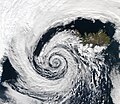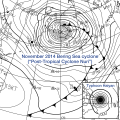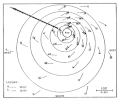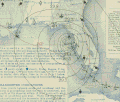Portal:Tropical cyclones
The Tropical Cyclones Portal
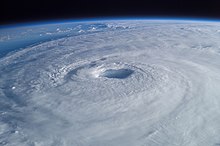
A tropical cyclone is a storm system characterized by a large low-pressure center, a closed low-level circulation and a spiral arrangement of numerous thunderstorms that produce strong winds and heavy rainfall. Tropical cyclones feed on the heat released when moist air rises, resulting in condensation of water vapor contained in the moist air. They are fueled by a different heat mechanism than other cyclonic windstorms such as Nor'easters, European windstorms and polar lows, leading to their classification as "warm core" storm systems. Most tropical cyclones originate in the doldrums, approximately ten degrees from the Equator.
The term "tropical" refers to both the geographic origin of these systems, which form almost exclusively in tropical regions of the globe, as well as to their formation in maritime tropical air masses. The term "cyclone" refers to such storms' cyclonic nature, with anticlockwise rotation in the Northern Hemisphere and clockwise rotation in the Southern Hemisphere. Depending on its location and intensity, a tropical cyclone may be referred to by names such as "hurricane", "typhoon", "tropical storm", "cyclonic storm", "tropical depression" or simply "cyclone".
Types of cyclone: 1. A "Typhoon" is a tropical cyclone located in the North-west Pacific Ocean which has the most cyclonic activity and storms occur year-round. 2. A "Hurricane" is also a tropical cyclone located at the North Atlantic Ocean or North-east Pacific Ocean which have an average storm activity and storms typically form between May 15 and November 30. 3. A "Cyclone" is a tropical cyclone that occurs in the South Pacific and Indian Oceans.
Selected named cyclone -
Tropical Storm Vera, known in the Philippines as Severe Tropical Storm Pining, originated from a system that began to develop within a monsoon trough several hundred kilometers north of Guam on September 10. The JTWC issued a TCFA early on September 11, and the system was classified as a tropical depression later that day. The depression moved slowly and erratically at first, but then it was steered west-northwest by a subtropical ridge. It strengthened into a tropical storm, being named Vera, and reached its peak intensity with winds of 95 km/h (60 mph). The storm then weakened due to increasing wind shear and made landfall in China. It weakened further and became an extratropical cyclone on September 16. The remnants of the storm moved east-northeast over South Korea and Japan before dissipating on September 19.
Vera caused widespread flooding throughout Eastern China, with the worst damage occurring in Zhejiang Province, which reached $351 million (1989 USD), and at least 162 people were killed in and 354 were missing. 882 people were injured, and 3.1 million homes were damaged or destroyed. Additionally, significant losses also occurred in nearby Jiangsu Province, where 34 people were killed and an estimated 2,000 more were injured. Throughout eastern China, approximately 5.86 million households (23 million people) were affected by flooding triggered by the storm. According to news estimates, a total of 500–700 people died as a result of Vera. (Full article...)
Selected article -
The 1827 North Carolina hurricane caused severe impacts along its track through the northeastern Caribbean Sea and up the East Coast of the United States in late August 1827. First observed over the Leeward Islands on August 17, the storm continued northwest, passing over Puerto Rico and the northern coastline of Hispaniola. It moved through the Turks and Caicos Islands and then the Bahamas by August 21 and curved northward. Although there is some discrepancy in its track, the hurricane moved ashore somewhere along the North Carolina coastline on August 25, perhaps at Category 4 intensity on the modern-day Saffir–Simpson hurricane wind scale. The cyclone emerged back into the Atlantic Ocean around Norfolk, Virginia, and grazed the New England coastline before last being observed offshore Nova Scotia on August 28. Along its track, numerous vessels were damaged, capsized, or run aground. The combination of heavy rainfall and ferocious winds caused severe crop damage, damaged or destroyed structures, and snapped and uprooted trees. Overall, the storm was responsible for more than six deaths and at least two injuries. (Full article...)
Selected image -

Selected season -

The 2020 North Indian Ocean cyclone season was the costliest North Indian Ocean cyclone season on record, mostly due to the devastating Cyclone Amphan. it was an above average season featuring 5 cyclonic storms. The North Indian Ocean cyclone season has no official bounds, but cyclones tend to form between April and November, with peaks in late April to May and October to November. These dates conventionally delimit the period of each year when most tropical cyclones form in the northern Indian Ocean. The season began on May 16 with the designation of Depression BOB 01 in the Bay of Bengal, which later became Amphan. Cyclone Amphan was the strongest storm in the Bay of Bengal in 21 years and would break Nargis of 2008's record as the costliest storm in the North Indian Ocean. The season concluded with the dissipation of Cyclone Burevi on December 5. Overall, the season was slightly above average, seeing the development of five cyclonic storms.
The scope of the season is limited to the Indian Ocean in the Northern Hemisphere, east of the Horn of Africa and west of the Malay Peninsula. There are two main seas in the North Indian Ocean – the Arabian Sea to the west of the Indian subcontinent, abbreviated ARB by the India Meteorological Department (IMD); and the Bay of Bengal to the east, abbreviated BOB by the IMD. (Full article...)
Related portals
Currently active tropical cyclones

Italicized basins are unofficial.
- North Atlantic (2025)
- No active systems
- East and Central Pacific (2025)
- No active systems
- West Pacific (2025)
- No active systems
- North Indian Ocean (2025)
- No active systems
- Mediterranean (2024–25)
- No active systems
- South Pacific (2024–25)
- No active systems
- South Atlantic (2024–25)
- No active systems
Last updated: 16:54, 13 January 2025 (UTC)
Tropical cyclone anniversaries

January 15
- 1958 - Typhoon Ophelia crashed a reconnaissance aircraft plane, killing the crew of nine.
- 1995 - A cyclone in the Mediterranean Sea (pictured) developed an eye-like structure, becoming one of the few possible Mediterranean tropical cyclones on record.

January 16
- 1948 - Typhoon Karen intensifies into a super typhoon to the north of Palau, making it the earliest super typhoon to form in the Northwest Pacific basin.
- 2012 - Subtropical Depression Dando (pictured) made a rare landfall in southern Mozambique, washing away bridges in South Africa. The storm killed 10 people.

January 17
- 1971 - Cyclone Ada hit the Whitsunday Islands off the Queensland coast. Ada killed 14 people and caused $390 million in damage.
- 1998 - A tropical depression struck Mozambique and moved southward through the country; heavy rainfall and landslides caused 87 deaths.
- 1985 - Cyclone Eric (pictured) moved through Fiji at peak intensity, killing 25 people and causing $40 million in damage.
Did you know…
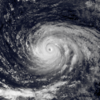



- …that the Joint Typhoon Warning Center considers that Typhoon Vera (pictured) of 1986 is actually two distinct systems, formed from two separated low-level circulations?
- …that Cyclone Freddy (track pictured) in 2023 was the longest-lasting tropical cyclone recorded?
- …that the typhoons of 2024—Yinxing, Toraji, Usagi, and Man-yi (pictured)—made history as the first recorded instance since 1951 of four tropical cyclones coexisting in November?
- …that Hurricane Otis (pictured) in 2023 was the first Pacific hurricane to make landfall at Category 5 intensity and surpassed Hurricane Patricia as the strongest landfalling Pacific hurricane on record?
General images -

Category 5 hurricanes are tropical cyclones that reach Category 5 intensity on the Saffir–Simpson hurricane scale. They are by definition the strongest hurricanes that can form on planet Earth. Hurricanes of this intensity are infrequent in the northeastern Pacific Ocean; only 21 have formed since 1959, and they generally develop in clusters during the same year. Landfalls by such storms are rare due to the generally westward path of tropical cyclones in the Northern Hemisphere. (Full article...)
Topics
Subcategories
Related WikiProjects
WikiProject Tropical cyclones is the central point of coordination for Wikipedia's coverage of tropical cyclones. Feel free to help!
WikiProject Weather is the main center point of coordination for Wikipedia's coverage of meteorology in general, and the parent project of WikiProject Tropical cyclones. Three other branches of WikiProject Weather in particular share significant overlaps with WikiProject Tropical cyclones:
- The Non-tropical storms task force coordinates most of Wikipedia's coverage on extratropical cyclones, which tropical cyclones often transition into near the end of their lifespan.
- The Floods task force takes on the scope of flooding events all over the world, with rainfall from tropical cyclones a significant factor in many of them.
- WikiProject Severe weather documents the effects of extreme weather such as tornadoes, which landfalling tropical cyclones can produce.
Things you can do
 |
Here are some tasks awaiting attention:
|
Wikimedia
The following Wikimedia Foundation sister projects provide more on this subject:
-
Commons
Free media repository -
Wikibooks
Free textbooks and manuals -
Wikidata
Free knowledge base -
Wikinews
Free-content news -
Wikiquote
Collection of quotations -
Wikisource
Free-content library -
Wikiversity
Free learning tools -
Wikivoyage
Free travel guide -
Wiktionary
Dictionary and thesaurus











